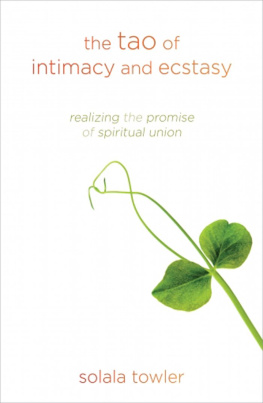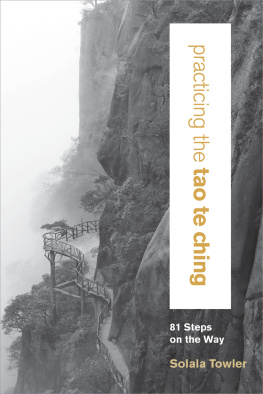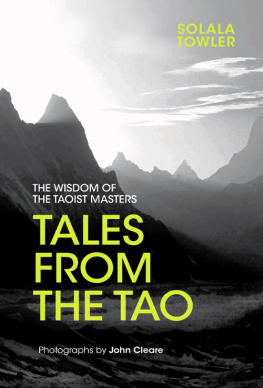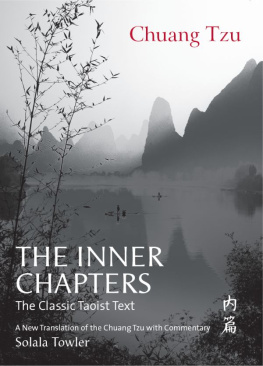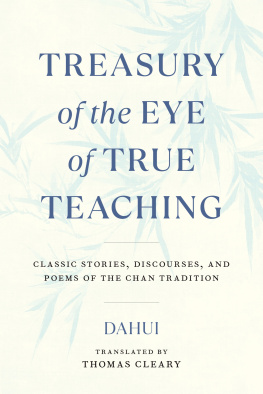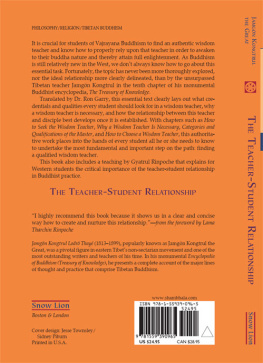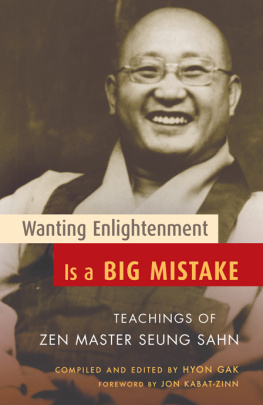The
Spirit
of Zen
The
Spirit
of Zen
Teaching Stories on the
Way to Enlightenment
SOLALA
TOWLER
Zen Buddhism is a way and a view of life which does not belong to any of the formal categories of modern Western thought. It is not religion or philosophy or a type of science. It is an example of what is known in India and China as a way of liberation.
Alan Watts, The Way of Zen
Contents
Introduction
Zen is probably the most well-known yet misunderstood version of Buddhism in the West. Everyone thinks they know what Zen means some sort of blank state of being where whatever is happening is fine. Or perhaps the word Zen is taken to denote the core meaning of an activity: the Zen of Gardening, the Zen of Auto Repair, the Zen of Driving, etc. Yet, as any student of Buddhism can tell you, this is not true Zen. True Zen is so much more than this.
Most people, even those with a bit of understanding of Zen Buddhism, know little of Chan, the much earlier form of Zen that flourished in China 700 years before Zen became established in Japan.
Historically, the foundation of Chan Buddhism in China was laid by a strange and powerful teacher from India, known as Bodhidharma, or, as he is known in China, Da Mo. He is said to have arrived in China around the year 500 CE and his form of Buddhism emphasized meditation over sutra study and devotional practices (the more popular form of Buddhism at the time). Bodhidharma is usually portrayed in statues and paintings in China and Japan as an extremely stern, even gruff character. He was a no-nonsense type of teacher who even mouthed off to the emperor (see Bodhidharma Comes to the West, ).
Bodhidharmas form of Buddhist practice did not exactly catch on during his lifetime but his disciples, or what are called the patriarchs, carried his teachings forward and within a few hundred years (not long to a sincere Buddhist) Zen or Chan practices flourished all over China and eventually in Korea, Vietnam and Japan.
Bodhidharma found so few people willing to take up his extreme form of Buddhism that he ended up sitting in a cave for nine years, facing a wall! (Whether this is meant to be taken literally or to symbolize the fact that he spent a long time there, history does not tell us, but it does tell us that he was an extremely strong practitioner!)
At the time, his teachings were considered weird if not heretical. As Bill Porter tells us, describing the teachings of Bodhidharmas spiritual heir, Second Patriarch Huike: he aroused the anger of other monks who found the Zen teachings of Bodhidharma anathema, if not absurd. How could we all be buddhas? And how could Enlightenment be less than a thought away, since everyone knew it took lifetimes to achieve?
Today this form of Buddhism is the most well known in the West, though there are many other forms of Buddhism as well, some of which, such as Pure Land, actually have many more practitioners.
(The other form of Buddhism most familiar in the West is Tibetan Buddhism, a mixture of Mahayana and ancient shamanic practices.) Bodhidharmas teaching was much simpler and yet much more challenging. As mentioned, his Buddhism did not rely upon sutras but was instead more concerned with a direct mind transmission outside of books (words). He taught that Accumulation of knowledge is useless and clouds awareness.
This is similar to Taoist teachings emphasizing belly knowledge over mind or intellectual knowledge. Indeed, Chan Buddhism was heavily influenced by the ancient philosophy and practices of Taoism and emerged as a uniquely Chinese form of Buddhism.
China has always been a great melting pot of various religions and nationalities and has been equally adept at immersing foreign influences in its ever-bubbling pot and coming up with a unique Chinese version.
The term zazen, meaning simply to sit, is similar to the Taoist practice of zuowang, which is often translated as sitting in oblivion or sitting and forgetting. A commentary on the Tao Te Ching, written during the time of the Tang Dynasty by the emperor Xuanzong, says: Zuo here is associated with non-action, with a resting of the spirit in immobility, whereas wang means utter forgetfulness of ones own body. Thus the expression implies a double forgetting: the forgetting which is the method of meditation and the forgetting of this very method itself. This is a perfect description of Zen meditation practice as well.
For many people the most attractive elements of Zen practice are the non-reliance on scripture, the use of humour and paradox in teaching, the being in the present moment attitude, the earthy simplicity of mindful practice in daily life, and the simple yet profound practice of just sitting.
This is very similar to the teachings of Chinese Taoism, which had a direct influence on the formation of Zen (Chan). After all, Zen Buddhism is quite a different creature than the Mahayana Buddhism that developed in India and the rest of Southeast Asia. It was in its travels and transformation from India to China to Japan that Indian Buddhism became what we know today as Zen.
D. T. Suzuki states, Zen is the product of the Chinese soil from the Indian seed.
Another interesting thing that Bodhidharma brought to China was a series of exercises that evolved into what we know today as wu shu or martial arts (often mistakenly referred to in the West as kung fu). It is said that when he arrived at the original Shaolin temple, he noticed that the monks there were very unfit and unhealthy from sitting for long periods and studying sutras, with little or no physical exercise. So Bodhidharma got the monks up and moving both for the benefit of their health and so that they would be less easy prey to marauding bandits as a form of self-defence. Today the name of Shaolin is synonymous with amazing martial arts, and the temple is visited by numerous people from all over the world.
Bill Porter quotes a contemporary Zen priest concerning the connection of modern-day Zen to Bodhidharma, or the First Patriarch, as follows:
External circumstances have changed, but external circumstances are not important. Zen is about cultivating the mind. The mind hasnt changed, and the way we cultivate hasnt changed. When Bodhidharma arrived in China, Buddhism had already been in China for more than 400 years. But people who practiced Buddhism then were concerned with the translation and study of sutras and the attainment of spiritual powers... But Zen isnt something you can see. Its how you see. You cant find it in a book. Zen is your mind, your Buddha mind. That hasnt changed.
When Zen moved to Japan it was taken up by the samurai class, who layered onto it their very strict and often rigid code of conduct and ethics that they called bushido. This is the form of Zen practice that is most familiar to Westerners today and is most prevalent in Japan. It emphasizes just sitting with little or no movement practice.
Heres an interesting description of the difference between Japanese Zen and the Chinese Zen:
The differences between the Chinese and the Japanese ways of meditating tell something about each culture. While the Japanese tend to be rigid and quite formal in their meditation style and ceremony, the Chinese often appear more relaxed. Between periods of sitting meditation... Japanese meditators walk slowly in a single circle, sometimes at an excruciatingly slow pace... Chinese, on the other hand, do such walking meditation in a relaxed way, each person walking at their own pace in a wide circular area, swinging their arms and making a good healthy hike out of it.



